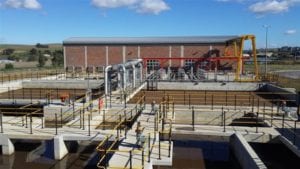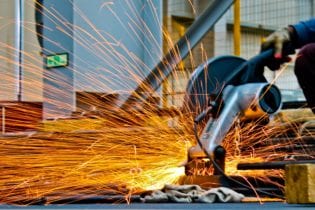The Malmesbury wastewater treatment works is situated at the south-west end of this fast-growing community. It treats both domestic and industrial wastewater and discharges the treated effluent into the Diep River.
It recently installed a new hybrid membrane bio-reactor which is designed to treat an average flow of 10 000 m3 of wastewater per day. The construction of the activated sludge plant is allowing the Swartland Municipality to set new standards in the treatment of wastewater. Membrane filtration The use of membrane filtration in municipal wastewater treatment has significant beneficial impacts on the treatment process. Despite the reduced footprint of the works, the treated wastewater achieves a quality which cannot be attained with a conventional wastewater treatment works. The final effluent, without further treatment, even satisfies the stringentrequirements for European bathwater. Implementation of the MBR plant at Malmesbury WWTW The site of the treatment works is located in Diep River which flows into the Milnerton Lagoon and ultimately into the Atlantic Ocean. Apart from the nutrient removal required, the WWTW historically also had problems with sludge that washed from the systems and into the river during high flow. Various options for upgrading the works had been presented. The municipality decided on MBR technology primarily for the following reasons: –- If the treatment works was to be upgraded using conventional activated sludge technology, the maximum treatment capacity that could be accommodated on the current site would have been limited to about 15 Ml/d. According to current flow forecasts this meant that an alternative site for a treatment works should have been identified within the next decade. Using MBR technology, the treatment capacity that could be accommodated on the current site could be increased two-to threefold.
- With an MBR plant, the risks of solids carry-over into the environment were virtually eliminated.
- The quality of the effluent will be such that disinfection will normally not be required.
Each of four MBR tanks is sized for five membrane units (or packs), but initially only four have been installed in each tank, with the remainder of the membrane units available for later installation. The current available membrane capacity is sufficient for hydraulic design capacity of 2 x ADWF with an allowance to ultimate increase total peak capacity of the MBR plant by a further 25% x ADWF with additional membrane units.
Upgraded Malmesbury WWTW flow description All flow arriving at the works is split at the end of the inlet works, (at the outlet chamber) in a ratio of 85:15 up to a total flow of 20 Ml/d ie peak dry water flow of which the smaller fraction is routed to the existing treatment works. Up to a total inflow of 20 Ml.d all flow diverted to the existing Pasveer Ditch is pumped back to the MBR-plant and all treated effluent from the plant will pass through the membranes. When the total flow into the work exceeds 29 Ml/d the existing clarifiers will become operational and be utilised to settle sludge from all flow more than 20 Ml/d. This configuration ensures that, uptothe design peak, dry weather flow, all treated with effluent from the upgraded works, flows from the works via the membrane train/units. When the flow to the works exceeds the design peak dry weather flow rate, excess flow flows to the secondary sedimentation tank. The membrane activate sludge process Once a bacterium has treated the wastewater biologically, it is filtered through the pores of the membranes. With a pore diameter of less than a thousandth of a millimetre, these filters retain not only all solid matter, but also virus and pathogenic agents. At the same time, the bacteria which are responsible for the biological wastewater treatment, also remain in the reactor. Since the system makes use of a physical barrier, and not sedimentation tanks, to separate the sludge from the treated water, the sludge concentration in the MBR systems can be much more concentrated than in a conventional treatment works. This means that that bioreactors area approximately a third of the size of those to be found in normal conventional wastewater treatment works. In the case of Malmesbury WWTW, the membranes in the bioreactors are in the form of submerged membranes in the bioreactors and are thus integrated into the biological treatment stage. The membrane filters comprises individual modules which are equipped with a large number of fine, spaghetti-like hollow fibres. The actual filtering process takes place on the outer surface of these fibres. The treated wastewater is drawn through the walls of the hollow fibres using a slight suction force. The water, after passing through the membrane is called permeate. A blockage of the filter is countered through regular backwashing using the permeate. In addition, air is blown into the waste water below the filter, which then flows over the surface of the filter and sets the individual fibres in an oscillating motion. Particles and solid matter which adhere to the surface of the filters are loosened and washed off. Membrane filtration makes smaller tank volumes possible, replaces classical conventional secondary setting tanks, obviates the need for disinfection and exceeds by far the efficiency of normal sand filtration. The construction of the membrane plant had minimal impact to the existing plant. The work to convert the existing system into the new configuration was schedules to start in the low season to minimise the impact of the operation of the current pant. To allow the plant to continue treating wastewater, the MBR plant was commissioned in stages. This allowed the engineers to start hydraulic testing of equipment and commissioning the plant without major impacts on the rest of the treatment units. In conclusion, the upgrading of the wastewater treatment plant to a MBR system was a success satisfying all the objectives set at the planning stage. By utilising the existing infrastructure, keeping the existing anaerobic digester and Pasveer Ditch tanks, a significant cost saving was realised. The upgrade was carried out in a stepped-wise process and thus interruption to the operation of the existing plant was minimised. The system is designed to accommodate seasonal flow variation, and provide operational flexibility and energy saving. The upgrade increases the plant hydraulic capacity to 20Ml/d, while achieving the effluent requirements and puts the plant in a position to serve its purpose into the future. Information source: Swartland Municipality & Aurecon







